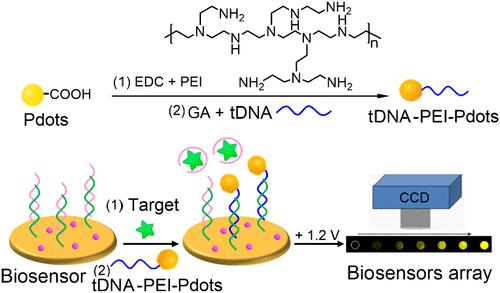当前位置:
X-MOL 学术
›
Anal. Chem.
›
论文详情
Our official English website, www.x-mol.net, welcomes your
feedback! (Note: you will need to create a separate account there.)
Coupled Poly(ethylenimine) Coreactant to Enhance Electrochemiluminescence of Polymer Dots for Array Imaging of Protein Biomarkers
Analytical Chemistry ( IF 6.7 ) Pub Date : 2024-02-28 , DOI: 10.1021/acs.analchem.4c00112 Lele Li 1 , Weiwei Chen 2 , Xiangfu Hu 1 , Zhiwei Tang 1 , Chao Wang 1 , Huangxian Ju 1
Analytical Chemistry ( IF 6.7 ) Pub Date : 2024-02-28 , DOI: 10.1021/acs.analchem.4c00112 Lele Li 1 , Weiwei Chen 2 , Xiangfu Hu 1 , Zhiwei Tang 1 , Chao Wang 1 , Huangxian Ju 1
Affiliation

|
Traditional electrochemiluminescent (ECL) bioanalysis suffers from the demand for excessive external coreactants and the damage of reaction intermediates. In this work, a poly(ethylenimine) (PEI)-coupled ECL emitter was proposed by covalently coupling tertiary amine-rich PEI to polymer dots (Pdots). The coupled PEI might act as a highly efficient coreactant to enhance the ECL emission of Pdots through intramolecular electron transfer, reducing the electron transfer distance between emitter and coreactant intermediates and avoiding the disadvantages of traditional ECL systems. Through modification of the PEI–Pdots with tDNA, a sequence partially complementary to cDNA that was complementary to the aptamer of target protein biomarker (aDNA), tDNA–PEI–Pdots were obtained. The biosensors were produced using Au/indium tin oxide (ITO) with an aDNA/cDNA hybrid, and an ECL imaging biosensor array was constructed for ultrasensitive detection of protein biomarkers. Using vascular endothelial growth factor 165 (VEGF165) as a protein model, the proposed ECL imaging method containing two simple incubations with target samples and then tDNA–PEI–Pdots showed a detectable range of 1 pg mL–1 to 100 ng mL–1 and a detection limit of 0.71 pg mL–1, as well as excellent performance such as low toxicity, high sensitivity, excellent selectivity, good accuracy, and acceptable fabrication reproducibility. The PEI-coupled Pdots provide a new avenue for the design of ECL emitters and the application of ECL imaging in disease biomarker detection.
中文翻译:

耦合聚(乙烯亚胺)共反应剂增强聚合物点的电化学发光,用于蛋白质生物标志物的阵列成像
传统的电化学发光(ECL)生物分析面临着外部共反应物过多和反应中间体损坏的问题。在这项工作中,通过将富含叔胺的PEI与聚合物点(Pdot)共价偶联,提出了一种聚(乙烯亚胺)(PEI)偶联的ECL发射体。偶联的PEI可以作为高效共反应剂,通过分子内电子转移增强P点的ECL发射,减少发射体和共反应中间体之间的电子转移距离,避免传统ECL系统的缺点。通过用tDNA修饰PEI-P点,获得与靶蛋白生物标志物(aDNA)适体互补的cDNA部分互补的序列,得到tDNA-PEI-P点。该生物传感器是使用 Au/氧化铟锡 (ITO) 与 aDNA/cDNA 混合体生产的,并构建了 ECL 成像生物传感器阵列,用于蛋白质生物标志物的超灵敏检测。使用血管内皮生长因子 165 (VEGF 165 ) 作为蛋白质模型,所提出的 ECL 成像方法包含与目标样品进行两次简单的孵育,然后 tDNA-PEI-Pdots 显示出 1 pg mL –1至 100 ng mL –1的可检测范围检测限为 0.71 pg mL –1 ,并且具有低毒性、高灵敏度、优异的选择性、良好的准确性和可接受的制造重现性等优异性能。 PEI耦合的Pdots为ECL发射器的设计和ECL成像在疾病生物标志物检测中的应用提供了新的途径。
更新日期:2024-02-28
中文翻译:

耦合聚(乙烯亚胺)共反应剂增强聚合物点的电化学发光,用于蛋白质生物标志物的阵列成像
传统的电化学发光(ECL)生物分析面临着外部共反应物过多和反应中间体损坏的问题。在这项工作中,通过将富含叔胺的PEI与聚合物点(Pdot)共价偶联,提出了一种聚(乙烯亚胺)(PEI)偶联的ECL发射体。偶联的PEI可以作为高效共反应剂,通过分子内电子转移增强P点的ECL发射,减少发射体和共反应中间体之间的电子转移距离,避免传统ECL系统的缺点。通过用tDNA修饰PEI-P点,获得与靶蛋白生物标志物(aDNA)适体互补的cDNA部分互补的序列,得到tDNA-PEI-P点。该生物传感器是使用 Au/氧化铟锡 (ITO) 与 aDNA/cDNA 混合体生产的,并构建了 ECL 成像生物传感器阵列,用于蛋白质生物标志物的超灵敏检测。使用血管内皮生长因子 165 (VEGF 165 ) 作为蛋白质模型,所提出的 ECL 成像方法包含与目标样品进行两次简单的孵育,然后 tDNA-PEI-Pdots 显示出 1 pg mL –1至 100 ng mL –1的可检测范围检测限为 0.71 pg mL –1 ,并且具有低毒性、高灵敏度、优异的选择性、良好的准确性和可接受的制造重现性等优异性能。 PEI耦合的Pdots为ECL发射器的设计和ECL成像在疾病生物标志物检测中的应用提供了新的途径。




















































 京公网安备 11010802027423号
京公网安备 11010802027423号